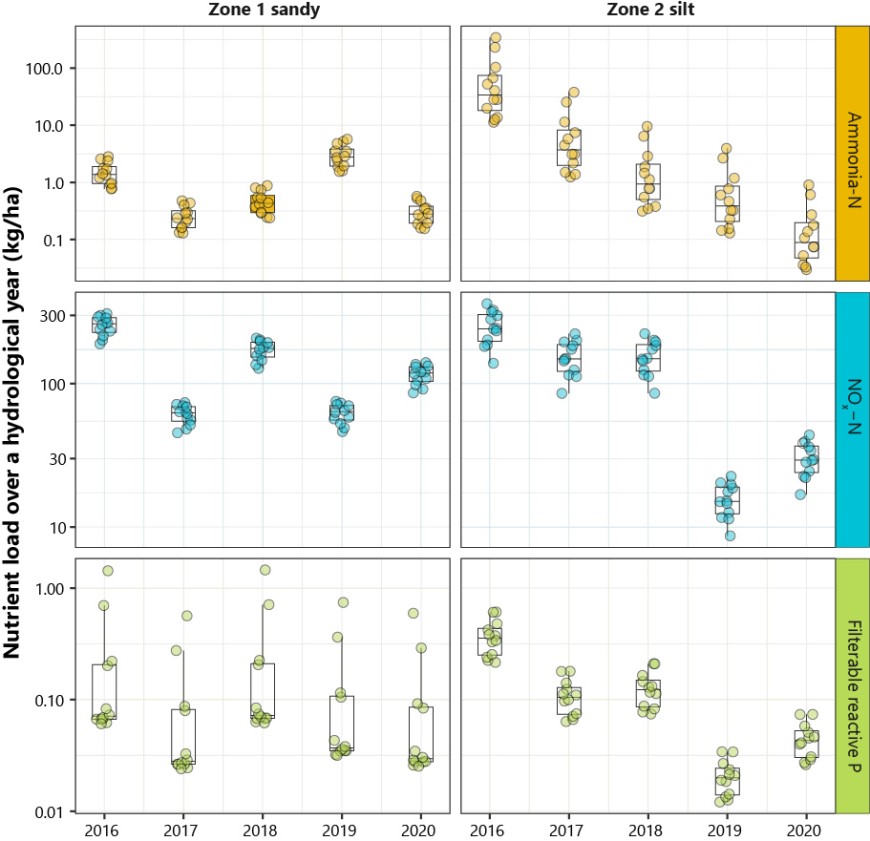Leaching losses under cropping and variable-rate irrigation
Variable-rate irrigation (VRI) systems have been developed to manage spatially variable soils, or several crops in different areas (zones) under the irrigator. VRI has been shown to reduce drainage and nutrient losses compared with uniformly applied irrigation water, but there is a lack of data for nitrogen (N) and phosphorus (P) leaching losses under VRI systems for mixed cropping systems. This study measured N and P leaching losses using drainage flux meters over 5 years, under two contrasting management zones and a variable-rate centre-pivot irrigator for a mixed cropping system.
The study was conducted at Massey University’s No.1 Farm, near Palmerston North. We used a mixed cropping site with sheep grazing between cropping events. The site had a centre-pivot irrigator with variable-rate control that irrigates two management zones. Management zones were determined using an electromagnetic and gamma radiometric survey in the paddock, in conjunction with soil physical sampling and laboratory analyses. The resulting zones were: zone 1, a Manawatū fine sandy loam, which is a deep, free-draining soil; and zone 2, a poorly drained Manawatū silt loam. Drainage flux meters were installed to collect drainage leachate. Soil water balance data and statistical modelling evaluated nutrient leaching losses over 5 years.
The mean leaching load of NOx-N (nitrate + nitrite) across 5 years was 133 and 121 kg N/ha/yr for zone 1 and zone 2, respectively. The nutrient loads are presented in the figure, which shows the variability in individual drainage flux meters. The dominant form of N was nitrate. The mean leaching load of filterable reactive P across all years was 0.17 and 0.14 kg P/ha/yr for zone 1 and zone 2, respectively. The nutrient loads generally had greater uncertainty in zone 2. The study also found that drainage flux meters worked well for the free-draining soil (zone 1) but were less reliable in the poorly drained soil (zone 2).
The practical implication of the study is that where there are spatially variable soils (or crops) under irrigators, irrigation can be managed in specific zones to reduce irrigation-induced drainage and nutrient leaching. The study also highlights the need to map soil types and understand their characteristics (e.g. through using digital data from proximal sensing surveys and the laboratory) under the irrigator, at a paddock scale that farmers can practically use.

Nutrient loads (kg N/ha/year or kg P/ha/year) of ammonia-N, NOx-N (nitrate + nitrite), and filterable reactive phosphorus (P) for the two management zones, per year (1 July to 30 June). The points are for each drainage flux meter. For boxplots the median is shown, and the boxes represent the inter-quartile range (25th and 75th percentiles), and whiskers represent 1.5 times the inter-quartile range. Note that the scale is logarithmic.
Further reading
Drewry JJ, Hedley CB, McNeill SJ, El-Naggar AG, Karakkattu KK, Horne DJ 2024. Nitrogen and phosphorus leaching losses under cropping and zone-specific variable-rate irrigation. Soil Research 62(1): SR23136. https://doi.org/10.1071/SR23136

